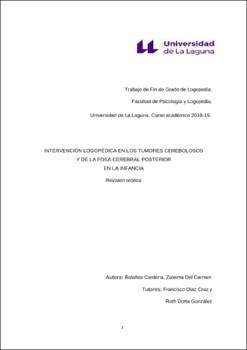Intervención logopédica en los tumores cerebelosos y de la fosa cerebral posterior en la infancia
Date
2019Abstract
La oncología pediátrica representa la segunda causa de mortalidad, a partir del
primer año de vida, después de los ACV. Los tumores cerebrales en la infancia se desarrollan entre los 0 y 14 años, dejando graves secuelas en el cuerpo. El tipo de tumor dependerá del área cerebral donde se desarrolle.
El Registro Nacional de Tumores Infantiles alude que desde 1980 se reconocen un total de 20.747 casos en España, de los que 9.820 hacen referencia a los niños de 0 a 14 años. Partiendo del mismo registro nacional, los datos apuntan a que, en la actualidad, las cifras son menores.
Este trabajo se centra en los tumores que se originan en el cerebro y que causan secuelas que afectan al habla y el lenguaje. Son los denominados tumores cerebelosos y el tumor de la fosa cerebral posterior, situado en el base del cráneo pudiendo producir alteraciones lingüísticas, mutismo, disfasias,
disartrias, dificultades en la velocidad de procesamiento, morfosintaxis, etc.
Resulta llamativo, que pese a las alteraciones del habla y del lenguaje que provocan estos tumores, la figura del logopeda no aparezca públicamente en el curso de esta enfermedad. Pediatric oncology represents the second cause of mortality, from the first year
of life, after stroke. Brain tumors in childhood develop between 0 and 14 years, leaving serious sequelae in the body. The type of tumor will depend on the brain area where it develops.
The National Registry of Childhood Tumors refers that since 1980, a total of 20,747 cases have been recognized in Spain, of which 9,820 refer to children aged 0 to 14 years. Starting from the same national registry, the data indicate that, at present, the figures are lower.
This work focuses on tumors that originate in the brain and cause sequelae that affect speech and language. They are called cerebellar tumors and the tumor of the posterior cerebral fossa, located at the base of the skull and can produce linguistic alterations, mutism, dysphasias, dysarthria, difficulties in processing speed, morphosyntax, etc.
It is striking, that despite the speech and language changes caused by these tumors, the figure of the speech therapist does not appear publicly in the course of this disease.





